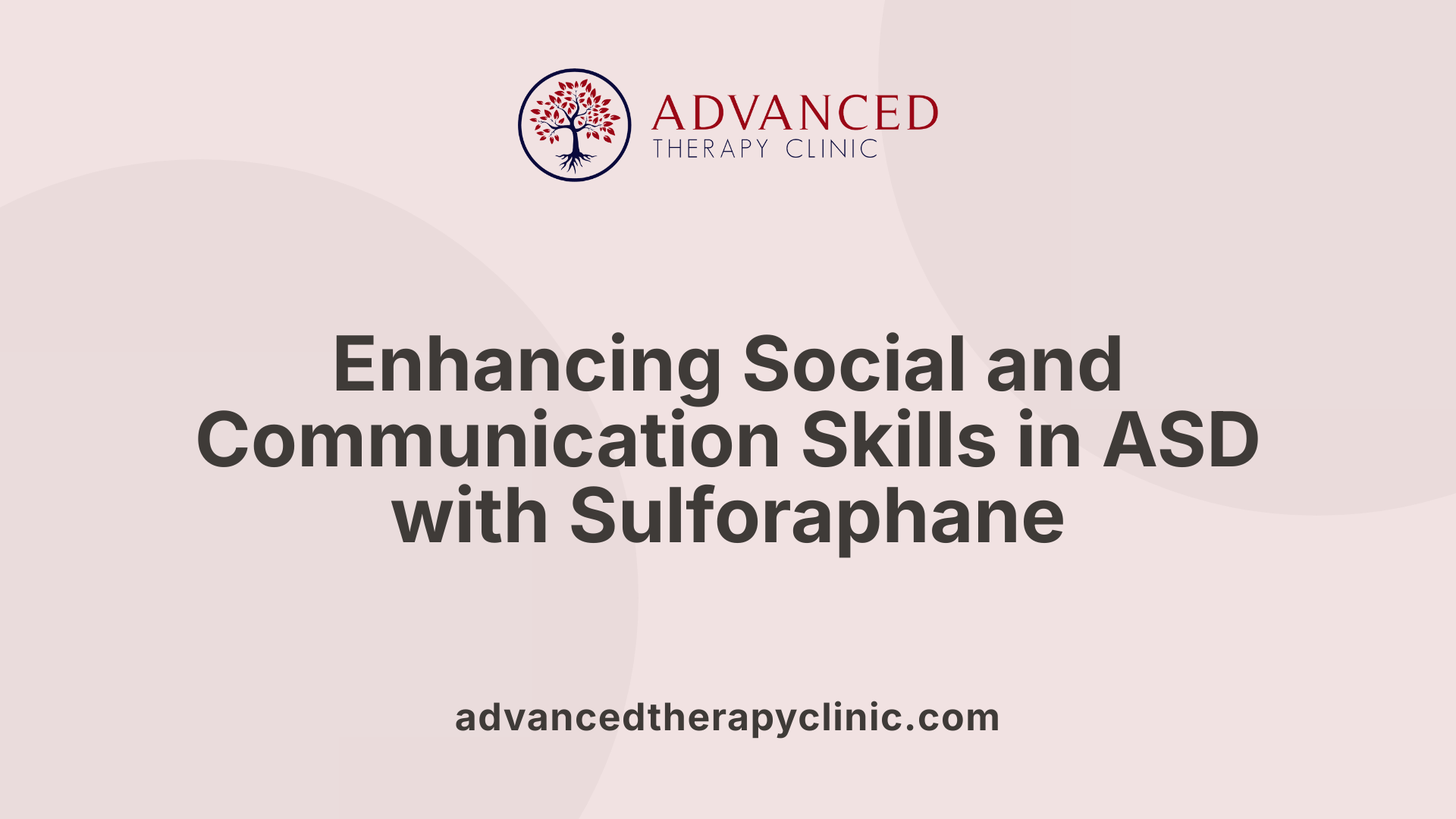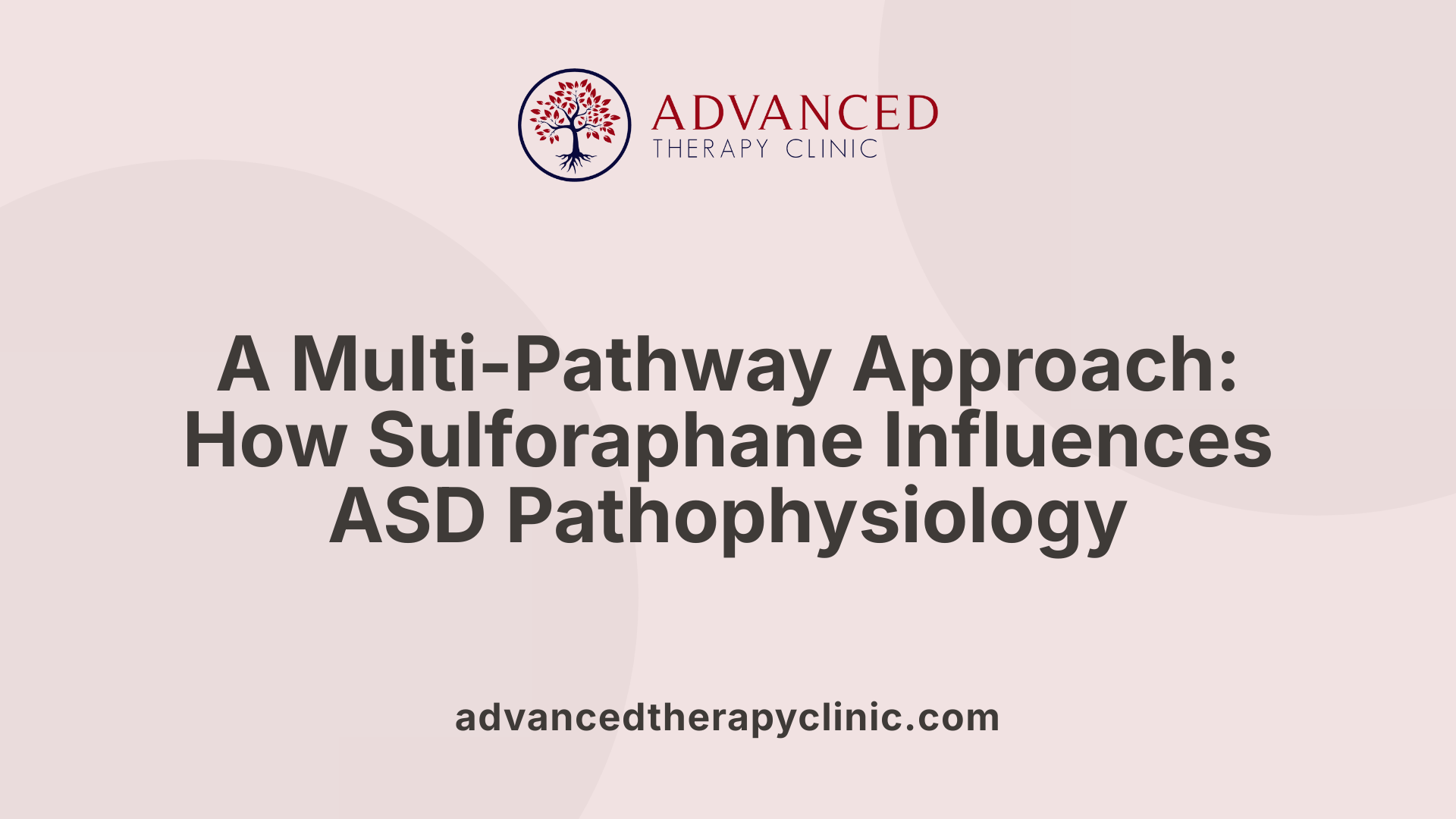Sulforaphane Treatment of Autism


The Rising Interest in Alternative Autism Treatments
With no FDA-approved pharmacological treatments effectively addressing core symptoms of Autism Spectrum Disorder (ASD), families and clinicians alike are turning their attention to complementary and alternative medicine (CAM). Among emerging therapies, sulforaphane (SFN), a natural compound derived from cruciferous vegetables such as broccoli, has been gaining attention for its potential to improve behavioral and cognitive symptoms of ASD. This article delves into the science behind sulforaphane's therapeutic promise, clinical evidence supporting its use, and ongoing research efforts.
Understanding Sulforaphane: A Potent Antioxidant From Nature

What is Sulforaphane and Where Does It Come From?
Sulforaphane (SFN) is a natural compound classified as an isothiocyanate. It is derived predominantly from cruciferous vegetables such as broccoli, kale, and cabbage. Among these, broccoli sprouts are particularly rich sources of sulforaphane, making them central in research and dietary supplementation aimed at health benefits.
Chemical Nature and Bioavailability
As a small molecule, sulforaphane exhibits the ability to cross the blood-brain barrier efficiently. This characteristic allows it to directly affect brain tissue and supports its potential as a neuroprotective agent. Its bioavailability is enhanced when consumed through fresh sprouts or specially prepared extracts, allowing SFN to exert physiological effects beyond the digestive tract.
Neuroprotective Potential of Sulforaphane
SFN’s capacity to traverse into the brain enables it to influence neurological pathways and function. It acts primarily by modulating antioxidant defenses and reducing oxidative stress, which is a harmful process implicated in numerous neurological disorders, including Autism Spectrum Disorder (ASD). This neuroprotective effect positions sulforaphane as a promising candidate for supporting brain health and mitigating neurological impairments.
By bridging natural dietary sources with brain health benefits, sulforaphane showcases the therapeutic potential hidden within common vegetables, opening avenues for interventions in neurodevelopmental conditions such as ASD.
Autism Spectrum Disorder: An Overview of Core Challenges
What is Autism Spectrum Disorder?
Autism Spectrum Disorder (ASD) is a complex neurodevelopmental condition characterized by difficulties in social communication and interaction, alongside restricted, repetitive behaviors. Individuals with ASD often face challenges in verbal communication and display varying degrees of behavioral symptoms.
Core Behavioral and Cognitive Symptoms
People on the spectrum commonly exhibit impaired social skills, struggles with maintaining eye contact, and delays in language development. Behaviorally, they might show repetitive actions, insistence on routines, and heightened sensitivity to sensory input. Cognitive functions such as information processing and social cognition can also be affected.
The Gap in FDA-Approved Treatments
Currently, there are no FDA-approved medical treatments that directly address the core symptoms of ASD. This treatment gap leaves families and healthcare providers searching for alternative options to manage and improve behavioral and cognitive outcomes.
Why Consider Complementary and Alternative Medicine (CAM)?
Due to the lack of definitive pharmacological interventions, many families turn to complementary and alternative medicine (CAM) therapies. These options aim to target underlying biological factors linked to ASD, such as oxidative stress and neuroinflammation. One promising CAM therapy under study is sulforaphane—a compound found naturally in cruciferous vegetables known for its antioxidant and neuroprotective properties.
Biological Mechanisms Linking Sulforaphane to Autism
Impact on redox metabolism and mitochondrial function
Sulforaphane (SFN) plays a crucial role in regulating redox metabolism and enhancing mitochondrial function, both of which are often impaired in individuals with Autism Spectrum Disorder (ASD). By improving the balance between reactive oxygen species and antioxidants, SFN helps reduce oxidative stress, a condition linked to cellular damage in ASD.
Modulation of immune dysregulation and neuroinflammation
Immune system irregularities and neuroinflammation are common contributors to ASD symptoms. SFN modulates these responses by downregulating inflammatory pathways, thereby helping to normalize immune function and reduce neuroinflammation within the brain.
Influence on synaptic dysfunction
Synaptic dysfunction is a hallmark of ASD, impacting communication between neurons. SFN has demonstrated potential in improving synaptic integrity and function, which may translate into better cognitive and behavioral outcomes for individuals with ASD.
Activation of Nrf2-ARE pathway
A key biological pathway influenced by SFN is the Nrf2-ARE (nuclear factor erythroid 2–related factor 2–antioxidant response element) pathway. SFN activates Nrf2, a transcription factor that promotes the expression of protective genes involved in combating oxidative stress and maintaining cellular health.
Cellular antioxidant defense enhancement
By stimulating the Nrf2-ARE pathway, SFN enhances cellular antioxidant defenses, increasing the production of enzymes and molecules that neutralize harmful free radicals. This contributes to reduced oxidative stress and protection against DNA damage in ASD.
Collectively, these mechanisms support the potential neuroprotective effects of SFN, addressing core biological abnormalities associated with ASD and improving behavior and cognitive function.
The Role of Oxidative Stress and Neuroinflammation in ASD
What is Oxidative Stress and Its Role in ASD?
Oxidative stress occurs when there is an imbalance between reactive oxygen species production and the body's ability to detoxify these harmful compounds. In individuals with Autism Spectrum Disorder (ASD), elevated oxidative stress is a notable biological factor that can damage cells and impair neurological function.
How Does Neuroinflammation Contribute to ASD Symptoms?
Neuroinflammation refers to inflammation within the brain that can disrupt normal signaling and synaptic function. This chronic immune activation is frequently observed in ASD and is believed to exacerbate behavioral and cognitive symptoms, including social difficulties and repetitive behaviors.
How Might Sulforaphane Counteract Oxidative Stress and Neuroinflammation?
Sulforaphane (SFN), a compound found in cruciferous vegetables like broccoli, has shown promising effects against these biological challenges. It activates the Nrf2-ARE pathway, enhancing cellular antioxidant defenses and reducing oxidative damage. Furthermore, SFN upregulates genes that protect against inflammation and DNA damage. Clinical trials demonstrate that SFN supplementation significantly improves behavioral symptoms in ASD, likely by targeting oxidative stress and neuroinflammatory pathways. This effect is supported by consistent findings of improved social interaction and communication following SFN treatment.
Overall, sulforaphane’s ability to modulate oxidative stress and neuroinflammation provides a potential therapeutic approach to mitigate core biological abnormalities underlying ASD symptoms.
Clinical Trial Designs Studying Sulforaphane in Autism
What types of clinical trials have studied sulforaphane in ASD?
Several types of clinical trials have investigated sulforaphane (SFN) as a treatment for Autism Spectrum Disorder (ASD). These include randomized placebo-controlled trials, which randomly assign participants to receive either SFN or a placebo, ensuring rigorous evaluation of its effects. Additionally, open-label studies, where both researchers and participants know the treatment being administered, have also contributed valuable insights into SFN's potential benefits.
What are the typical trial durations and dosing regimens?
The durations of SFN clinical trials typically range from 8 to 18 weeks. For example, one landmark study administered SFN orally to young men with ASD for 18 weeks, followed by a 4-week washout period. In ongoing research, participants are often given three capsules of SFN daily for about 8 weeks. These dosing regimens aim to assess both short- and medium-term effects on ASD symptoms.
Which assessment scales are used to measure outcomes?
Clinical trials utilize validated behavioral and cognitive assessment tools to track changes due to SFN treatment. Commonly employed scales include:
- Aberrant Behavior Checklist (ABC): Measures problem behaviors such as irritability and hyperactivity.
- Social Responsiveness Scale (SRS): Assesses social communication and interaction difficulties.
- Clinical Global Impression Improvement Scale (CGI-I): Provides an overall clinician-rated impression of improvement after treatment.
These scales allow standardized evaluation of changes in behavior, social responsiveness, and clinical status, providing robust data on SFN effectiveness.
Overall, the variety in trial designs and consistent use of rigorous assessment tools have helped build a strong foundation of evidence supporting the potential of sulforaphane as a neuroprotective and behavior-modifying agent in autism.
Key Clinical Findings: Behavioral Improvements with Sulforaphane
Reduction in Aberrant Behavior Checklist (ABC) scores
Clinical trials administering sulforaphane orally to individuals with Autism Spectrum Disorder (ASD) have demonstrated notable reductions in aberrant behaviors. In a double-blind, placebo-controlled trial involving young men with ASD, sulforaphane supplementation led to a 34% reduction in ABC scores after an 18-week treatment period. This significant decrease reflects meaningful improvements in maladaptive behaviors associated with ASD.
Decrease in Social Responsiveness Scale (SRS) scores
Alongside the ABC improvements, participants receiving sulforaphane exhibited a 17% decline in scores on the Social Responsiveness Scale (SRS), which measures deficits in social behavior typically present in ASD. This improvement indicates enhanced social responsiveness and more effective social communication following sulforaphane treatment.
Improved social interaction, verbal communication, and abnormal behavior
Beyond the numerical scores, sulforaphane-treated individuals showed observable positive changes in core areas such as social interaction and verbal communication. The treatment mitigated abnormal behaviors, contributing to better overall social functioning. These outcomes suggest sulforaphane's potential in addressing several facets of ASD symptomatology.
Reversion of symptoms after discontinuation
The improvements seen during sulforaphane use were not permanent. After a 4-week washout period following cessation of treatment, behavioral scores tended to revert toward baseline levels. This underscores the importance of sustained supplementation to maintain behavioral benefits and exemplifies sulforaphane’s role in symptom management rather than a cure.
These clinical findings collectively highlight sulforaphane's promising potential as a complementary therapy for improving behavior and social function in ASD populations, supported by objective and subjective assessments.
| Measure | Improvement with Sulforaphane | Description |
|---|---|---|
| Aberrant Behavior Checklist | 34% reduction | Decreased maladaptive and disruptive behaviors |
| Social Responsiveness Scale | 17% reduction | Enhanced social communication and responsiveness |
| Behavioral Observations | Notable improvement | Better social interaction and verbal communication |
| Post-treatment Observation | Symptoms revert | Behavioral scores return near baseline after stopping |
This evidence supports ongoing research and clinical interest in sulforaphane as a safe and effective option to alleviate ASD behavioral symptoms.
Cognitive and Social Communication Effects Observed in Trials

Improvements in Communication Scores After 12 Weeks
Clinical studies investigating sulforaphane (SFN) supplementation in individuals with Autism Spectrum Disorder (ASD) have documented notable cognitive and social communication enhancements. One trial involving children with ASD showed a significant improvement in communication scores after 12 weeks of SFN treatment, indicating meaningful progress in verbal skills and interactive capacity.
Effects on Social Communication Measured by SRS-II
The Social Responsiveness Scale (SRS-II), a standardized questionnaire assessing social communication abilities and related deficits, has been used to quantify SFN's effects. Participants receiving SFN demonstrated a significant reduction in SRS-II scores, translating to improved social responsiveness and fewer social challenges commonly observed in ASD. These positive shifts underscore SFN’s potential in enhancing social interaction and empathy.
Clinical Global Impression Improvement Scale Outcomes
Further evidence comes from the Clinical Global Impression Improvement Scale (CGI-I), which captures overall clinical improvement. In double-blind, placebo-controlled trials, individuals treated with SFN showed considerable global improvements in behavior and cognitive function compared to placebo groups. Reported benefits included better social interaction, decreased abnormal behaviors, and enhanced verbal communication.
Overall, these clinical findings suggest that SFN administration can deliver meaningful advancements in social communication and cognitive domains among ASD populations. The improvements observed across validated behavioral and clinical scales support continued exploration of SFN as a promising adjunct intervention for ASD symptoms.
Safety Profile and Side Effects of Sulforaphane Treatment
How safe is sulforaphane for individuals with ASD?
Sulforaphane (SFN) treatment has been generally well tolerated in clinical studies involving individuals with Autism Spectrum Disorder (ASD). The compound shows negligible toxicity, making it a promising therapeutic option with minimal health risks.
What adverse effects have been reported with sulforaphane supplementation?
Some mild side effects have been reported during trials, including vomiting and irritability. However, these occurrences were rare and happened at rates comparable to those in placebo groups, suggesting that these symptoms might not be specifically related to SFN.
How does SFN's safety compare to placebo?
The similarity in side effect frequencies between SFN-treated participants and placebo groups indicates that SFN’s safety profile is favorable and that it does not introduce significant additional risks. This makes it a viable complementary and alternative medicine (CAM) option for families seeking treatments for ASD.
In summary, current evidence supports that sulforaphane is safe with only minor and infrequent adverse events reported, reinforcing its potential as a well-tolerated intervention for managing ASD symptoms.
Gut Microbiota Alterations Linked to Sulforaphane
Changes in Gut Bacteria in ASD-like Rats and Children
Research indicates that sulforaphane (SFN) treatment leads to noteworthy changes in the gut microbiota composition in both ASD-like rat models and children diagnosed with Autism Spectrum Disorder (ASD). In rat studies, SFN administration altered the abundance of several bacterial taxa, presenting a distinct microbial profile compared to untreated counterparts. Changes in children, while less pronounced, revealed consistent patterns aligning with those observed in animal models.
Specific Taxa Affected (Bacillales, Staphylococcaceae, Staphylococcus)
Among the bacterial groups impacted by SFN treatment, Bacillales, Staphylococcaceae, and particularly Staphylococcus demonstrate marked shifts. These taxa showed a decreased abundance following SFN supplementation. This reduction is significant because alterations in these bacteria have been previously associated with ASD pathophysiology. Both rats and children shared this trend, suggesting SFN’s potential role in normalizing gut microbial imbalances linked to ASD.
Correlation of Gut Microbiota Changes with Behavioral Improvements
Network analysis from the studies revealed meaningful correlations between shifts in certain gut bacteria and improvements in social behaviors and ASD symptoms. For instance, taxa such as Prevotella and Haemophilus were connected with enhanced social interactions and communication following SFN treatment. Such findings support the hypothesis that modifying the gut microbiome through SFN could contribute to alleviating behavioral symptoms in ASD, potentially via gut-brain axis interactions. These preliminary results highlight the importance of gut microbiota in ASD and position SFN as a promising agent to target both microbial composition and neurological function.
Animal Model Evidence Supporting Sulforaphane's Efficacy

Significant Social Behavior Improvements in ASD-like Rats
Several studies using animal models that mimic autism spectrum disorder (ASD) have shown promising results with sulforaphane (SFN) treatment. Notably, ASD-like rats receiving SFN exhibited marked enhancements in social behaviors, which are often impaired in ASD.
Increased Social Sniffing in the Three-Chamber Test
A key indicator of social interaction in rodent models, the three-chamber social test, demonstrated that SFN-treated ASD-like rats spent significantly more time engaged in social sniffing compared to untreated controls. This increase in social sniffing time reflects improved social curiosity and interaction capacity, paralleling behavioral improvements seen in human clinical trials.
Consistent Microbiota Changes in Animal Models
In addition to behavioral benefits, SFN treatment altered the gut microbiota composition of ASD-like rats. Noteworthy changes include shifts in specific microbial taxa such as Bacillales, Staphylococcaceae, and Staphylococcus. These changes are important because gut microbiota imbalances have been implicated in ASD pathology. Interestingly, some of these microbiota alterations, especially the decreased abundance of Staphylococcus, were also observed in children with ASD following SFN treatment, suggesting a potential mechanistic link between gut health and behavioral improvements.
Together, these animal studies bolster the evidence that sulforaphane positively affects both social behaviors and gut microbiota in ASD models. This dual impact supports its potential as a therapeutic agent for ASD, complementing findings from human clinical trials.
Linking Gut Microbiota Modulation to Behavioral Outcomes

Network analysis correlating microbiota with social behaviors
Recent studies have employed network analysis to explore the relationship between gut microbiota composition and social behavior changes in both ASD-like animal models and children with ASD. This approach has revealed significant correlations between the presence or abundance of specific bacterial taxa and improvements in social interactions and overall ASD symptoms following sulforaphane (SFN) treatment.
Role of Prevotella and Haemophilus taxa
Among the microbiota linked to behavioral outcomes, the genera Prevotella and Haemophilus stand out as particularly influential. Both taxa have been associated with behavioral improvements, suggesting they may play a role in mediating the positive effects of SFN. In animal models, these bacteria showed meaningful correlations with social behavior enhancements, while in children with ASD, changes in these taxa coincided with better communication and social responsiveness scores.
Potential microbiome-driven mechanisms in ASD improvement
The modulation of gut microbiota by SFN may influence the gut-brain axis, contributing to neurochemical and immune system changes that benefit behavior and cognition. Alterations such as the decreased abundance of Staphylococcus taxa, consistent across both ASD-like rats and patients, suggest a shift toward a more balanced microbial environment. This shift could reduce inflammation and oxidative stress—factors known to contribute to ASD pathophysiology—and enhance neuroprotective pathways, thereby improving social behavior and communication.
The interplay between SFN supplementation, gut microbial community shifts, and behavioral outcomes underscores the potential for microbiome-driven therapeutic strategies in ASD management. This growing body of evidence supports further research into targeted microbial modulation as part of comprehensive ASD treatments.
Integrating Neurophysiological and Neurochemical Research
Use of EEG to Assess Excitatory/Inhibitory Imbalance
Electroencephalography (EEG) is utilized in clinical research to examine brain activity patterns associated with Autism Spectrum Disorder (ASD). Specifically, EEG helps measure the excitatory/inhibitory (E/I) ratio—a crucial neurophysiological marker often disrupted in ASD. Studies evaluating sulforaphane (SFN) treatment include EEG assessments to understand how SFN might rebalance neural excitability and inhibition, potentially alleviating ASD symptoms.
Magnetic Resonance Spectroscopy to Measure Neurotransmitter Levels
Magnetic resonance spectroscopy (MRS) serves as a non-invasive method for quantifying brain neurotransmitters such as glutamate and gamma-aminobutyric acid (GABA). Since neurotransmitter imbalances contribute to ASD pathophysiology, MRS analysis allows researchers to observe changes in these chemicals following SFN supplementation. This sheds light on the neurochemical mechanisms through which SFN may exert its therapeutic effects.
Understanding Sulforaphane's Brain Chemistry Effects in ASD
Clinical trials are combining EEG and MRS with behavioral measures to build a comprehensive picture of SFN’s influence on brain function in ASD. Participants receiving SFN often show improvements in social communication and reduced symptom severity alongside alterations in neurophysiological and neurochemical markers. These multimodal approaches help clarify SFN’s role in modulating oxidative stress, neuroinflammation, and synaptic dysfunction—factors underlying ASD—thereby supporting its potential as an effective intervention.
By integrating neurophysiological and neurochemical research, ongoing studies aim to unravel the brain-based effects of sulforaphane and optimize its use in managing ASD symptoms.
Comprehensive Clinical Trial Approaches in Asia
Trial Involving 50 ASD Patients and 30 Healthy Controls
A notable clinical trial conducted in China recruited 50 individuals diagnosed with Autism Spectrum Disorder (ASD) alongside 30 healthy controls. This approach establishes a comparative framework to discern sulforaphane's (SFN) efficacy by contrasting treated ASD participants against neurotypical individuals.
Dosing Regimen: 3 Capsules Daily for 8 Weeks
Participants with ASD were instructed to ingest three capsules of SFN daily over an 8-week timeframe. This standardized dosing aimed to ensure sufficient bioavailability to trigger measurable neurological and behavioral changes during the trial period.
Inclusion/Exclusion Criteria Specifics
Strict inclusion and exclusion criteria were applied to select participants, ensuring all ASD diagnoses met standardized clinical parameters to maintain cohort homogeneity. Additionally, criteria addressed overall health status to exclude comorbidities or conditions that could confound SFN's effects or participant safety.
Use of Psychological, EEG, MRI, Metabolic Assessments
This multidisciplinary evaluation integrated multiple assessment tools:
Psychological Assessments: The Social Response Scale (SRS-II) was the primary outcome measure to gauge improvements in social communication, supplemented by autism severity scales such as OARS-5.
EEG Monitoring: Electroencephalography (EEG) helped assess the excitatory/inhibitory neural activity ratio, relevant to ASD neuropathophysiology.
MRI and Spectroscopy: Magnetic Resonance Imaging and magnetic resonance spectroscopy quantified neurotransmitter levels and examined brain function alterations.
Social Cognition Tests: Tests like Reading the Mind in the Eyes, Frith-Happe animations, and Strange Stories were employed to analyze higher-level social cognitive abilities.
Together, these methods provided a comprehensive view of SFN's impact on ASD at behavioral, neurophysiological, and biochemical levels, representing a rigorous clinical evaluation in the Asian context.
Measuring Social Cognition: Beyond Behavior Scores
Social cognition tests such as Reading the Mind in the Eyes
In addition to traditional behavior scales, clinical studies investigating sulforaphane (SFN) as a treatment for Autism Spectrum Disorder (ASD) include sophisticated social cognition tests. The Reading the Mind in the Eyes test evaluates an individual's ability to recognize emotions and mental states by looking only at the eye region of faces. This test captures subtle aspects of social perception often impaired in ASD, providing insight beyond what general behavior checklists can measure.
Frith-Happe animations and Strange Stories
Other advanced assessments used are the Frith-Happe animations and Strange Stories tests. The Frith-Happe animations require participants to interpret social interactions from animated shapes, thus testing theory of mind and the capacity to attribute intentions. Strange Stories involve understanding non-literal language and complex social scenarios, helping reveal the cognitive processes involved in social reasoning. These tests allow researchers to identify nuanced improvements in social cognition following SFN treatment.
Evaluating subtle cognitive changes with sulforaphane treatment
In a clinical trial involving SFN supplementation, changes in social communication were monitored not only through rating scales but also using these social cognition tests. By combining psychological assessments with neurophysiological tools such as EEG and MRI, researchers aim to correlate behavioral improvements with underlying brain function changes. This comprehensive evaluation helps to detect subtle cognitive enhancements induced by SFN that might not be reflected in global behavior scores alone, providing a richer understanding of how SFN contributes to improving social cognition in individuals with ASD.
Implications of Sulforaphane's Multi-Pathway Action on ASD Symptoms

Addressing core biological abnormalities
Sulforaphane (SFN) acts on several physiological pathways linked to Autism Spectrum Disorder (ASD), including redox metabolism, mitochondrial function, immune dysregulation, neuroinflammation, and synaptic dysfunction. By targeting these interconnected biological processes, SFN potentially addresses the underlying mechanisms contributing to ASD symptoms rather than only managing surface behaviors. Its ability to upregulate genes protective against oxidative stress, inflammation, and DNA damage further supports its role in modifying core ASD biology.
Potential for holistic symptom improvement
Clinical trials have demonstrated that SFN supplementation can lead to measurable improvements across a range of ASD-related domains such as behavior, social interaction, and cognitive function. For example, participants showed significant reductions in aberrant behaviors and social impairments, alongside better verbal communication. These multifaceted improvements suggest SFN’s action is broad, likely due to its impact on multiple neural and systemic pathways simultaneously, enhancing overall brain function rather than isolated symptoms.
The rationale for targeting oxidative stress and inflammation simultaneously
Oxidative stress and neuroinflammation are central contributors to ASD pathology and are closely linked processes. SFN activates the Nrf2-ARE pathway, elevating cellular antioxidant defenses which reduce oxidative damage. Concurrently, it modulates immune responses and neuroinflammatory pathways. Addressing both oxidative stress and inflammation together may provide synergistic benefits, making SFN a promising therapeutic candidate. This dual targeting aligns well with the complex, multifactorial nature of ASD’s biological disturbances, potentially leading to more effective symptom management and improved quality of life for individuals with ASD.
The Appeal of Sulforaphane in the Landscape of Autism Treatments
Why Are Families Turning to Sulforaphane for Autism?
Autism Spectrum Disorder (ASD) currently has no FDA-approved pharmacological treatments that effectively target its core symptoms. This gap in medical therapy leads many families to explore alternative and complementary medicine (CAM) options.
Minimal Side Effects Promote Sulforaphane Use
Among CAM remedies, sulforaphane (SFN), a natural compound derived from cruciferous vegetables like broccoli sprouts, has gained attention because it shows promising therapeutic potential with minimal side effects. Clinical trials report that SFN is well tolerated, with rare adverse events such as mild vomiting and irritability occurring at similar rates compared to placebo groups.
Families' Motivation for Exploring Natural Compounds
The appeal of SFN lies in its ability to positively influence biological pathways implicated in ASD, such as oxidative stress and neuroinflammation, potentially improving behavior and cognitive function. These encouraging findings motivate families to seek out SFN as a natural, low-risk supplement to help manage ASD symptoms when conventional options are limited or unavailable.
Challenges and Limitations in Current Sulforaphane Research
Variability in Clinical Trial Designs and Populations
Current sulforaphane studies on Autism Spectrum Disorder (ASD) vary widely in design, dosage, duration, and participant characteristics. For example, clinical trials include small sample sizes, ranging from a few dozen patients to under a hundred, and involve different age groups such as young men or children. Some studies are randomized and placebo-controlled, while others are open-label, making results difficult to compare directly.
Need for Larger Scale and Longer Duration Studies
Most sulforaphane trials typically last between 8 to 18 weeks, with some having a short washout period. However, ASD is a lifelong condition, and the long-term effects of sulforaphane supplementation remain unclear. Larger randomized controlled trials with extended follow-up are needed to confirm sustained efficacy and to observe if behavioral improvements translate into lasting functional gains.
Understanding Long-Term Safety and Efficacy
Although short-term studies report minimal side effects such as mild irritability or vomiting at rates similar to placebo, there is limited data on the long-term safety of sulforaphane use in ASD populations. Comprehensive safety profiles and monitoring for potential adverse effects over months or years are essential to support its use as a therapeutic option. Additionally, metabolic, neurophysiological, and microbiome impacts require further investigation to understand sulforaphane's full effect on brain health and ASD pathology.
These challenges highlight the importance of cautious optimism when interpreting current sulforaphane research and underscore the need for more rigorous, large-scale clinical trials to establish its role in ASD treatment.
Future Directions: Expanding Research on Sulforaphane and ASD
What new methods are being used in upcoming sulforaphane trials for ASD?
Future clinical trials are increasingly incorporating advanced neuroimaging techniques like EEG and MRI, along with metabolic analyses, to deepen understanding of SFN's effects on brain function and chemistry in individuals with ASD. These approaches enable researchers to link biochemical changes with improvements in social communication and behavioral symptoms, providing a more comprehensive evaluation than behavioral assessments alone.
How is dosing and formulation of sulforaphane being optimized?
Researchers are exploring the most effective dosing regimens and formulations to maximize SFN's bioavailability and therapeutic benefits. For example, current trials test oral administration of three capsules daily over eight weeks, but ongoing studies aim to refine these parameters to enhance clinical outcomes and minimize variability in patient response.
Are combination therapies with SFN being considered?
Combining SFN supplementation with behavioral interventions represents a promising area of research. Integrating SFN's neuroprotective and antioxidant properties with established behavioral therapies could potentially produce synergistic effects, improving social, cognitive, and communication abilities more effectively than either approach alone.
These future directions underscore a commitment to elucidating SFN's mechanisms and optimizing its use as a safe, adjunctive treatment option for ASD.
Possible Neuroprotective Benefits Beyond Symptom Management
Activation of Genes Protecting Against DNA Damage
Sulforaphane (SFN) has been shown to upregulate a range of genes that provide protection against oxidative stress, inflammation, and DNA damage. These biological factors are strongly associated with Autism Spectrum Disorder (ASD) pathology. By stimulating the Nrf2-ARE pathway, SFN enhances cellular antioxidant defenses, thereby potentially reducing the oxidative stress burden which contributes to neural dysfunction and damage.
Long-term Neuroprotection Hypotheses
Beyond immediate behavioral improvements, the activation of protective genetic pathways by SFN suggests possible long-term neuroprotective benefits. These effects may help shield neurons from ongoing oxidative injury and inflammation, which could delay or mitigate progressive changes in brain function. While clinical trials report improvements during treatment periods, the observed return toward baseline after stopping treatment underscores the possibility that continuous SFN support might be necessary for sustained neuroprotection.
Implications for Neurodevelopmental Trajectories
Because neuroinflammation and oxidative stress influence neurodevelopment, SFN’s ability to regulate these processes may influence the broader developmental trajectories in individuals with ASD. If SFN reduces cellular damage and supports mitochondrial function, it could contribute to improved synaptic functionality and brain connectivity during critical developmental windows. This opens avenues for using SFN not only as a symptom management tool but also as part of strategies aiming to alter underlying neurobiological pathways in ASD over the long term.
Patient and Family Perspectives on Sulforaphane Use
Reported Improvements in Quality of Life
Families of individuals with Autism Spectrum Disorder (ASD) who used sulforaphane (SFN) report noticeable improvements in overall quality of life. Many caregivers observe enhanced social interactions and reduced behavioral challenges, which collectively contribute to smoother daily routines. Improvements seen in clinical trials, such as reductions in aberrant behaviors and better communication skills, have translated to real-world benefits appreciated by families.
Perceived Benefits in Social and Communicative Domains
One of the most frequently highlighted benefits of SFN treatment is improvement in social and communicative abilities. Parents and patients have reported increased responsiveness, better verbal communication, and more meaningful engagement during social situations. These changes align with validated behavioral assessments from clinical research, including reductions in Social Responsiveness Scale (SRS) scores and improved social interactions noted both in children and young adults treated with sulforaphane.
Practical Considerations and Accessibility
Because SFN is derived from common cruciferous vegetables like broccoli sprouts, it represents a more accessible complementary approach than many other interventions. It is typically administered in capsule form, taken daily with minimal side effects, which encourages adherence. However, families often consider factors such as product quality, consistency of dosage, and cost. The absence of FDA-approved SFN treatments for ASD means families generally seek reputable suppliers or clinical trials offering the supplement. Despite these challenges, the promising clinical data encourages ongoing interest and use of SFN as a potential supportive therapy.
Comparing Sulforaphane to Other Complementary Therapies
Positioning SFN among ABA, Speech, and Physical Therapies
Sulforaphane (SFN) occupies a unique position among complementary therapies utilized for Autism Spectrum Disorder (ASD). While Applied Behavior Analysis (ABA), speech therapy, and physical therapy primarily offer targeted behavioral and developmental support, SFN acts at the biological level by modulating oxidative stress, neuroinflammation, and synaptic function. Unlike these established therapies that directly address skill acquisition and communication, SFN aims to improve underlying physiological mechanisms which may contribute to ASD symptoms.
Potential for SFN as Adjunctive Therapy
Owing to its neuroprotective properties and ability to cross the blood–brain barrier, SFN shows promise as an adjunctive treatment alongside conventional therapies. Clinical trials have demonstrated significant improvements in behavior, social interaction, and communication following SFN supplementation, often measured by validated scales such as the Aberrant Behavior Checklist and Social Responsiveness Scale. When combined with behavioral interventions like ABA and speech therapy, SFN may enhance overall treatment efficacy by targeting both neurological and behavioral domains.
Advantages and Limitations
One advantage of SFN is its origin from dietary sources like cruciferous vegetables, offering a generally favorable safety profile with minimal side effects reported in clinical studies. Its multi-target action on mitochondrial function, antioxidant defenses, and immune regulation sets it apart from therapies focused solely on symptom management. However, limitations include variability in individual responses and the need for more extensive, long-term studies to establish standardized dosing and confirm sustained benefits. Additionally, unlike ABA or speech therapy, SFN does not provide direct skill training, indicating its best use may be in combination with such therapies rather than as a standalone treatment.
Regulatory and Accessibility Considerations for Sulforaphane
Is Sulforaphane FDA-Approved for Autism Spectrum Disorder Treatment?
Currently, there is no FDA-approved medication specifically for treating Autism Spectrum Disorder (ASD). Sulforaphane (SFN), while showing promise in clinical trials for improving behavioral and cognitive symptoms in ASD, remains an investigational supplement rather than a formally authorized treatment. Families seeking alternative and complementary therapies often turn to SFN due to its potential benefits and generally mild side effects, but they should recognize it is not yet an established medical therapy regulated by the FDA.
How Are Sulforaphane Supplements Regulated?
SFN is commonly available as a dietary supplement derived from cruciferous vegetables like broccoli sprouts. Unlike prescription drugs, dietary supplements are not subjected to FDA pre-market approval for safety or efficacy. This lack of rigorous regulation means quality, purity, and concentration can vary widely between products. Consumers should be aware that supplement manufacturers are responsible for ensuring safety and accurate labeling but are not required to prove clinical benefits before marketing.
What Guidance Is Available for Families Considering SFN Therapy?
Given these regulatory aspects, families interested in SFN for ASD should consult healthcare professionals before starting supplementation. It is important to:
- Seek products from reputable manufacturers with third-party testing for quality
- Monitor for any adverse effects closely, although clinical studies report minimal side effects
- Use SFN as a complementary approach rather than a replacement for standard medical care
Ongoing research and clinical trials continue to evaluate the benefits, mechanisms, and safety profile of SFN in ASD. Until more definitive regulatory approvals and standardized formulations are available, cautious and informed use of sulforaphane supplements remains advisable.
Translating Research Into Practice: What Clinicians Should Know
Interpreting clinical trial data
Clinical trials of sulforaphane (SFN) for Autism Spectrum Disorder (ASD) consistently show promise, with improvements observed in behavior, social interaction, and communication. For example, a well-designed placebo-controlled trial found a 34% reduction in Aberrant Behavior Checklist (ABC) scores and a 17% decrease in Social Responsiveness Scale (SRS) scores after 18 weeks of SFN supplementation. Importantly, these behavioral improvements reverted after discontinuing SFN, suggesting a direct treatment effect. However, trials vary in size and duration, and while results are encouraging, larger-scale studies are needed to solidify clinical guidelines.
Counseling families on potential benefits and risks
Clinicians should inform families that SFN is derived from common vegetables like broccoli and has a strong safety profile in trials, with minimal adverse effects reported. Some mild side effects such as vomiting and irritability have occurred, but at rates similar to placebo. Families often turn to complementary and alternative medicine due to the lack of FDA-approved ASD treatments, and SFN offers an option backed by emerging evidence. Discussion should emphasize that SFN may improve core ASD symptoms—especially social behavior and communication—but is not a cure. Realistic expectations and ongoing monitoring are essential.
Monitoring and integration with existing therapies
SFN supplementation should be integrated thoughtfully with current therapies. Clinicians can use validated behavioral scales (e.g., ABC, SRS) to monitor progress and adjust interventions accordingly. Due to SFN’s effects on oxidative stress and neuroinflammation pathways, it may complement other approaches targeting neurological function. Monitoring for tolerance and any side effects should continue throughout treatment. Multidisciplinary collaboration ensures that SFN supplementation supports broader behavioral and therapeutic goals for patients with ASD.
The Science Behind Broccoli Sprouts: Practical Dietary Insights
Food Sources of Sulforaphane
Sulforaphane (SFN) is a natural compound mainly found in cruciferous vegetables such as broccoli, kale, and cabbage. One of the richest sources is broccoli sprouts, which contain significantly higher concentrations of SFN compared to mature broccoli. Including these vegetables in the diet can boost SFN intake naturally and provide antioxidant benefits linked to neuroprotection.
Bioavailability and Preparation Methods
The bioavailability of sulforaphane depends on how these vegetables are prepared and consumed. Cooking methods such as steaming lightly can help preserve the enzyme myrosinase, essential for converting glucoraphanin (a precursor) into active sulforaphane. Overcooking or boiling may destroy myrosinase and reduce SFN formation.
Raw or lightly steamed broccoli sprouts are considered the best options to maximize SFN absorption. Dietary supplements often provide SFN in a stabilized form or combined with myrosinase to enhance bioavailability. Additionally, consuming SFN with foods containing active myrosinase or gut bacteria capable of conversion may improve its effects.
Dietary Considerations Alongside Supplementation
While SFN supplements are used in clinical trials to study therapeutic effects on Autism Spectrum Disorder (ASD), incorporating SFN-rich foods can complement supplementation. However, supplementation typically provides a more controlled and potent dose.
It is advisable to follow a balanced diet including a variety of cruciferous vegetables to support overall health and antioxidant defenses. Individuals considering SFN supplements should consult healthcare providers, especially to manage dosage and monitor any possible side effects.
Maintaining consistent consumption and proper preparation methods can optimize the natural intake of sulforaphane, potentially enhancing its positive effects observed in behavioral and cognitive improvements in ASD studies.
Summary of Evidence: Sulforaphane as a Promising ASD Modulator
What Are the Behavioral and Cognitive Improvements Noted with Sulforaphane in ASD?
Multiple clinical trials have shown that sulforaphane (SFN) supplementation leads to significant improvements in behavioral and cognitive functions among individuals with Autism Spectrum Disorder (ASD). For instance, a placebo-controlled, double-blind study lasting 18 weeks observed a 34% reduction in the Aberrant Behavior Checklist (ABC) scores and a 17% decrease in Social Responsiveness Scale (SRS) scores after SFN treatment. Participants demonstrated enhancements in social interaction, verbal communication, and reductions in abnormal behaviors. Animal studies mirrored these results, showing enhanced social behavior in ASD-like rats. Furthermore, significant changes in communication abilities were noted in children with ASD after 12 weeks of SFN supplementation.
How Safe and Well Tolerated is Sulforaphane Treatment for ASD?
SFN has generally been well tolerated with minimal side effects reported across both human and animal studies. Minor adverse events such as vomiting and irritability occurred but at comparable rates in placebo groups, suggesting negligible toxicity. Additionally, the lack of severe adverse effects in these studies supports SFN's safety profile, which is especially relevant given that no FDA-approved treatments for ASD currently exist. Consequently, SFN presents a viable complementary and alternative medicine (CAM) option with a promising safety margin.
What Are the Potential Mechanisms Behind Sulforaphane's Clinical Effects?
SFN's beneficial effects in ASD appear to be driven through several physiological pathways. It induces antioxidant responses by activating the Nrf2-ARE pathway, thereby enhancing cellular defenses and reducing oxidative stress linked to ASD. SFN also modulates mitochondrial function, immune dysregulation, neuroinflammation, and synaptic abnormalities. It upregulates genes protective against oxidative stress, inflammation, and DNA damage. Moreover, alterations in gut microbiota composition have been observed following SFN treatment, with certain bacterial taxa correlating to behavioral improvements. These multi-faceted mechanisms suggest SFN targets core biological dysfunctions contributing to ASD symptoms.
| Aspect | Evidence Summary | Notes |
|---|---|---|
| Behavioral Improvements | 34% ABC score reduction; 17% SRS score reduction; increased social behavior in rats | Observed across randomized controlled and open-label trials |
| Cognitive Function | Improved communication scores; better social cognition assessments | Improvements seen after 8-18 weeks of supplementation |
| Safety Profile | Well tolerated; minor adverse events comparable to placebo | No serious adverse events reported |
| Mechanistic Actions | Activation of Nrf2-ARE pathway; neuroinflammation reduction; microbiota changes | Supports both neural and systemic contributors to ASD |
This evidence collectively supports sulforaphane as an emerging, well-tolerated modulator of ASD-related symptoms, working through diverse biological pathways to improve behavioral and cognitive outcomes.
Looking Ahead: Sulforaphane's Role in Autism Care
Sulforaphane has emerged as a compelling candidate in the quest for effective autism treatments, with clinical trials demonstrating encouraging improvements in social behavior, communication, and core symptomatology. Grounded in its antioxidant and anti-inflammatory properties, along with its multi-pathway mechanisms, SFN offers a novel approach that addresses biological underpinnings of ASD. Though larger and longer-term studies are needed to firmly establish efficacy and safety, current evidence supports sulforaphane as a well-tolerated complementary option deserving of further scientific and clinical exploration. Its integration into comprehensive therapy plans may one day transform outcomes for individuals living with autism.
References
Recent articles

How ABA Therapy Supports Emotional Growth in Children with Autism
Unveiling the Impact: ABA Therapy's Role in Emotional Development for Children with Autism

Can You Be Smart and Have Autism
Exploring Intelligence and Autism: Myths, Realities, and Interventions

Vocal Stimming In Autism
Understanding Vocal Stimming: A Key Aspect of Autism Spectrum Behaviors

How Speech Therapy Assists with Comprehending Complex Sentences
Unlocking Language Potential: The Role of Speech Therapy in Mastering Complex Sentences

Medication for Autism
Understanding the Role of Medication in Autism Spectrum Disorder Management

The Importance of Handwriting Development in Occupational Therapy
Handwriting Skills: A Critical Focus in Pediatric Occupational Therapy


